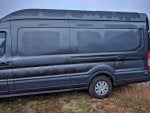What is the driving reason for people to fill those small spaces, rather than place a thermal break between those beams / columns and the van interior, and be done with it? :s
I don't understand what advantage there would be in filling those small cavities when the metal surrounding them will conduct heat from inside to outside (and vice versa), right around the insulation someone might bother to fill them with. There appears to be no reward to justify the effort.
Compare, for argument's sake, to the clearly advantageous method of covering a flat panel so the insulation separates the metal heat-conducting panel from the interior air.
Stuffing those metal boxes provides no barrier to the thermal bridge those structures create between outside and inside temperatures through the metal itself. It is certainly a way to keep whatever insulation you put in there warm, but what good is that?
This filling method on small spaces surrounded by metal seems much ado about nothing. If there is a reason based upon thermodynamics for doing so I'd be interested in learning what it might be.
I don't understand what advantage there would be in filling those small cavities when the metal surrounding them will conduct heat from inside to outside (and vice versa), right around the insulation someone might bother to fill them with. There appears to be no reward to justify the effort.
Compare, for argument's sake, to the clearly advantageous method of covering a flat panel so the insulation separates the metal heat-conducting panel from the interior air.
Stuffing those metal boxes provides no barrier to the thermal bridge those structures create between outside and inside temperatures through the metal itself. It is certainly a way to keep whatever insulation you put in there warm, but what good is that?
This filling method on small spaces surrounded by metal seems much ado about nothing. If there is a reason based upon thermodynamics for doing so I'd be interested in learning what it might be.







